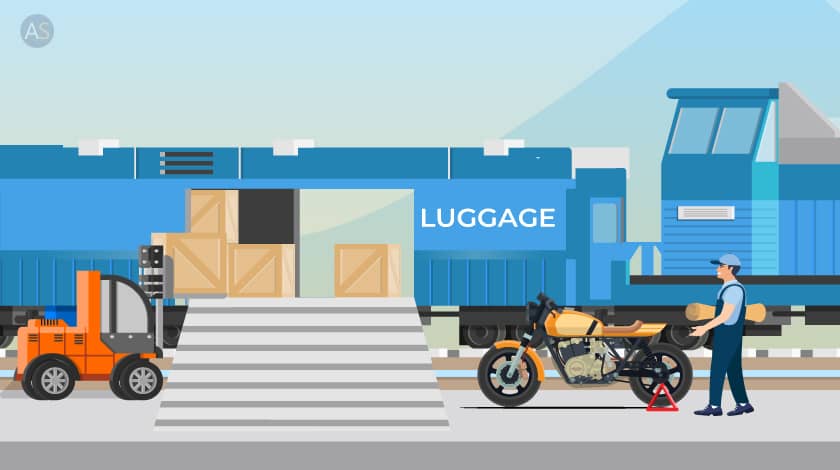The Ultimate Guide to Transport Bike by Train in India

Transporting a bike through Indian Railways can be a convenient and cost-effective option for many people. This comprehensive guide aims to provide you with all the necessary information and tips to help you successfully transport your bike via train in India.
This guide explains how Indian Railways transport bikes. It will cover bike preparation, needed documentation, booking, packing and loading, destination collection, fees and charges, and helpful tips.
Indian Railways offers two main options for transporting bikes: as luggage or as a parcel. This guide details the processes and requirements for both methods. Train transit saves time, effort, and money while safely delivering your bike.
Preparing Your Bike for Transportation
Preparing your bike for rail transport reduces damage and ensures a smooth ride. This part covers bike transportation arrangements.
Cleaning and Inspection
-
Start by thoroughly cleaning the bike. This will allow you to inspect it for any existing damage or issues that need to be addressed before transportation.
-
Wash the bike to remove dirt and grime.
-
Inspect the tires, brakes, lights, and other essential components.
-
Note any existing damage or issues to avoid confusion when collecting the bike at the destination.
Removing or Securing Accessories
Remove or secure any loose or detachable accessories on your bike to prevent them from getting damaged or lost during transit.
-
Remove items such as saddlebags, helmets, and other removable accessories.
-
Secure any loose cables, wires, or components with zip ties or tape.
-
Consider using a bike cover for added protection during transportation.
Documenting the Condition of Your Bike
It is crucial to document the current condition of the bike before transportation, as this can serve as evidence in case of any damage during transit.
-
Take clear, high-resolution photos of the bike from various angles, capturing any existing damage or issues.
-
Make a written record of the bike's condition, including details of any existing damage or issues.
Keep both the photos and written record safe for future reference, in case you need to file a claim with Indian Railways for any damage incurred during transportation.
Required Documentation
To avoid delays when booking the bike on Indian Railways, have the required documentation ready. Booking your bike for transportation requires these papers.
- Vehicle Registration Certificate: Your vehicle registration certificate (RC) serves as proof of ownership and contains important information about the bike. Make sure to carry the original RC or a photocopy when booking your bike for transportation.
- Insurance Documents: Carrying the bike's insurance documents is essential, as it confirms that the bike is insured and provides coverage in case of any damage during transit. Carry the original insurance documents or a photocopy when booking the bike.
- PUC Certificate: A valid Pollution Under Control (PUC) certificate is required to ensure that the bike complies with the pollution control standards set by the government. Carry the original PUC certificate or a photocopy when booking the bike for transportation.
- Identity Proof: You will also need to provide a valid identity proof when booking your bike for transportation. Acceptable forms of ID include:
- Aadhaar card
- PAN card
- Passport
- Voter ID card
- Driving license
Carry the original identity proof or a photocopy when booking your bike for transportation. By ensuring that you have all the required documentation in place, you can help facilitate a smooth and hassle-free booking process.
Booking the Bike as Luggage or Parcel
When planning a trip with your bike, you may need to book it as luggage or parcel to ensure it reaches your destination safely. In this section, we will discuss the procedures for booking your bike as luggage and parcel, as well as the pros and cons of each method.
Luggage Booking Procedure for Bike Transport by Train
To book the bike as luggage, follow these steps:
-
Disassemble and pack your bike: Some carriers require that you disassemble and pack the bike in a bike bag or box. Be sure to remove the pedals, deflate the tires, and turn the handlebars parallel to the frame to minimize the space needed.
-
Label your bike: Clearly label the bike with your name, address, and contact information to ensure it is properly identified during transit.
-
Arrive early: Arrive at the transportation hub well in advance of your departure time to ensure you have enough time to check in the bike as luggage.
-
Pay any applicable fees: Depending on the carrier, there may be additional fees for booking the bike as luggage. Be prepared to pay these fees upon check-in.
Booking Procedure for Bike Parcel in Train
Moving the bike as a parcel involves shipping it through a courier or postal service. Follow these steps to book the bike parcel service:
-
Choose a shipping service: Research different shipping services to find the one that best suits your needs in terms of cost, speed, and insurance coverage.
-
Disassemble and pack your bike: As with luggage booking, disassemble and pack the bike securely in a bike bag or box.
-
Weigh and measure your bike: Accurately weigh and measure the bike to ensure you pay the correct shipping fee and avoid any additional charges.
-
Label and insure your bike: Clearly label the bike with the destination address and your contact information. Consider purchasing shipping insurance to cover any potential damage during transit.
-
Drop off your bike: Bring the bike to the shipping service's drop-off location or arrange for a pick-up at your residence.
Packing and Loading Your Bike
Packing Materials and Methods
-
Bike box or bag: A sturdy bike box or padded bike bag provides protection during transit. Bike boxes are generally more protective, while bike bags offer more convenience and easier handling.
-
Bubble wrap or foam: Use bubble wrap or foam to protect delicate components, such as the frame, fork, and derailleur.
-
Zip ties or straps: Secure loose parts and cables to the frame to prevent movement during transit.
-
Padding: Use old towels, blankets, or foam padding to cushion the bike within the box or bag.
-
Disassemble your bike: Remove the pedals, deflate the tires, and turn the handlebars parallel to the frame. You may also need to remove the wheels, seat post, and saddle, depending on your bike's size and the dimensions of the bike box or bag.
-
Wrap delicate components: Use bubble wrap or foam to protect the frame, fork, derailleur, and any other delicate components.
-
Secure loose parts and cables: Use zip ties or straps to secure loose parts, such as the wheels and handlebars, to the frame. Also, secure any cables to prevent tangling or damage.
-
Place the bike in the box or bag: Carefully place the bike in the box or bag, ensuring all components are adequately cushioned and protected.
-
Fill empty spaces: Use padding materials to fill any empty spaces within the box or bag, preventing movement during transit.
Securing the Bike for Transport
Once the bike is packed, it's essential to secure it for transport. Follow these steps:
-
Use a bike rack or support: If your carrier provides bike racks or supports, use them to secure the bike in place. This will minimize movement and potential damage during transit.
-
Secure the bike with straps or bungee cords: Use straps or bungee cords to anchor the bike to fixed points within the transport vehicle, such as hooks or railings.
-
Double-check all fastenings: Before departure, double-check all fastenings to ensure they are tight and secure. It's better to spend a few extra minutes ensuring the bike is secure than to deal with damage later.
Loading the Bike onto the Train
-
Arrive early: Arrive at the train station with plenty of time to spare, as loading the bike may take longer than expected.
-
Locate the bike storage area: Train carriages often have designated bike storage areas. Ask station staff or consult the train layout to find the appropriate location.
-
Lift the bike onto the train: Carefully lift your bike onto the train and place it in the designated storage area. Be mindful of other passengers and their belongings.
-
Secure the bike: Use the train's bike racks or supports, if available, to secure your bike. Alternatively, use straps or bungee cords to anchor your bike to fixed points within the train carriage.
-
Keep an eye on your bike: While not always possible, try to choose a seat close to the bike storage area to keep an eye on your bike during the journey.
Collecting Your Bike at the Destination Station
Arrival and Collection Process
To ensure a smooth bike collection experience, follow these steps:
-
Plan your arrival: Make sure you have the destination station's layout and information on bike collection points handy. This will save you time and effort upon arrival.
-
Arrive early: If possible, arrive at the destination station a few minutes before your train's scheduled arrival to familiarize yourself with the area and locate the bike collection point.
-
Prepare your identification: Have your identification and any necessary documentation ready to present to station staff when collecting your bike. This may include your ticket, reservation details, or a photo ID.
Unloading and Unpacking Your Bike
-
Carefully remove the bike: Gently lift your bike out of the train's storage area or off the bike rack, being cautious not to damage any components or nearby luggage.
-
Find a suitable unpacking location: Look for a spacious, flat area away from foot traffic where you can safely unpack and reassemble your bike.
-
Unpack the bike: Remove any padding, straps, or zip ties used to secure your bike during transit.
-
Reassemble the bike: Attach the pedals, inflate the tires, and adjust the handlebars and seat to their correct positions. You may also need to reattach the wheels, seat post, and saddle, depending on your bike's disassembly.
Inspecting Your Bike for Damage
-
Inspect the frame: Carefully examine the bike frame for any signs of cracks, dents, or scratches. Ensure that the frame's integrity has not been compromised.
-
Check the components: Inspect the handlebars, pedals, wheels, and saddle for any signs of damage or excessive wear.
-
Test the gears and brakes: Cycle through your bike's gears and test the brakes to ensure they are functioning correctly and smoothly.
-
Check the tires: Inspect the tires for any cuts, punctures, or uneven wear. Ensure they are properly inflated and ready for your ride.
Fees and Charges
Understanding the Fee Structure
-
Carrier or shipping service: Costs can vary significantly between different transportation providers and shipping services. Research and compare fees before booking.
-
Bike size and weight: Some carriers or shipping services charge fees based on the size and weight of your bike. Be sure to accurately measure and weigh your bike to avoid surprises.
-
Travel distance: Fees may increase with the distance between your departure and destination points.
-
Advance booking: Booking your bike transportation in advance may result in discounted fees, while last-minute bookings could incur higher charges.
Also read: How much should you tip packers and movers
Additional Charges and Taxes
-
Excess baggage fees: If your bike exceeds the carrier's weight or size limits, you may be charged an excess baggage fee.
-
Insurance: Purchasing additional insurance to cover potential damage during transit may result in an extra cost.
-
Taxes: Some carriers or shipping services may charge taxes on top of the base fee.
-
Customs fees: If you're traveling internationally, you may need to pay customs fees or taxes upon arrival at your destination.
Payment Options
-
Credit or debit card: Most carriers and shipping services accept major credit and debit cards for payment.
-
Cash: Some carriers or shipping services may accept cash payments, particularly for in-person transactions.
-
Mobile payment apps: Many providers now accept popular mobile payment apps, such as Apple Pay, Google Pay, or PayPal.
-
Bank transfers: Some carriers or shipping services may allow for payment via bank transfer, particularly for international transactions.
Conclusion
Traveling with a bike can be an exciting and rewarding experience, allowing you to explore new destinations and create unforgettable memories. To ensure your journey goes smoothly, it's essential to properly plan and prepare for each aspect of transporting a bike.
We discussed the procedures for booking bike as luggage and parcel, as well as the pros and cons of each method. We provided tips on packing materials and methods, securing bike for transport, and loading it onto the train. We outlined the arrival and collection process, unloading and unpacking your bike, and inspecting it for damage. We explored the fee structure, additional charges and taxes, and payment options when transporting bike.











